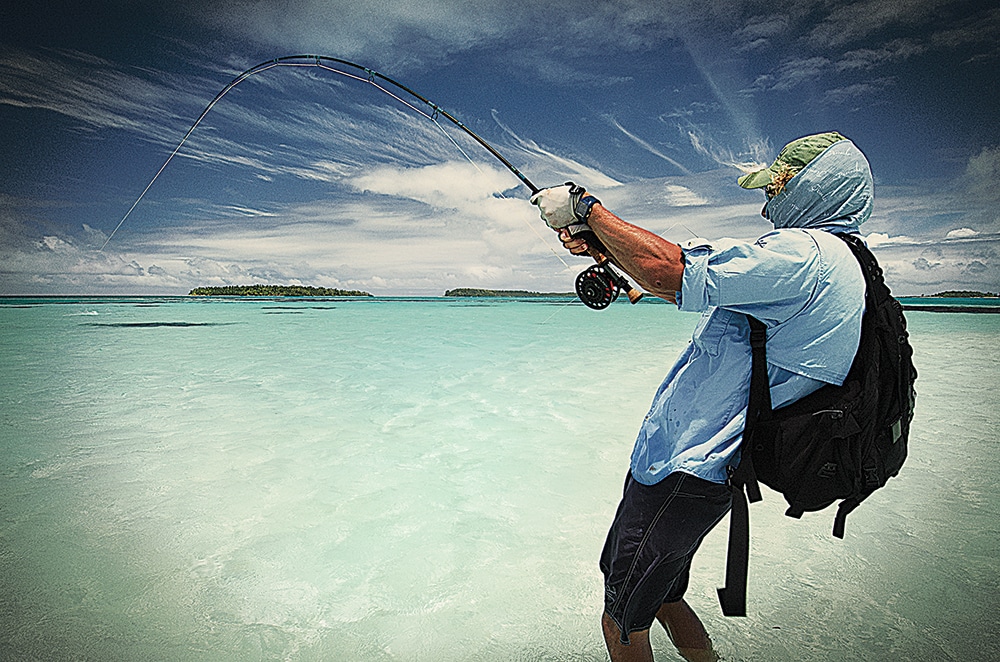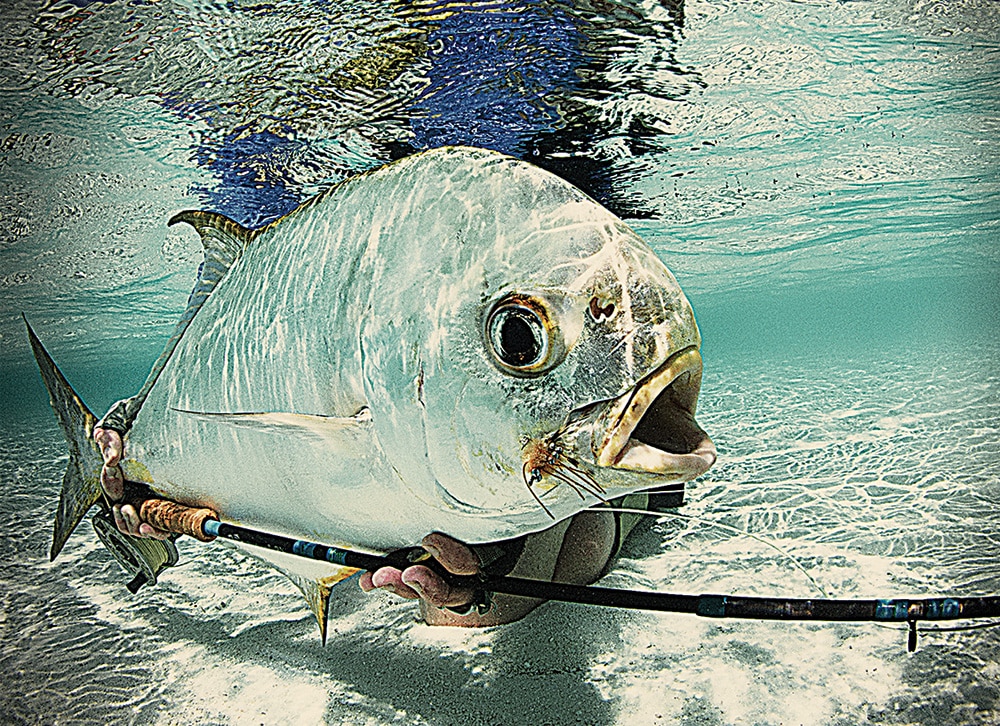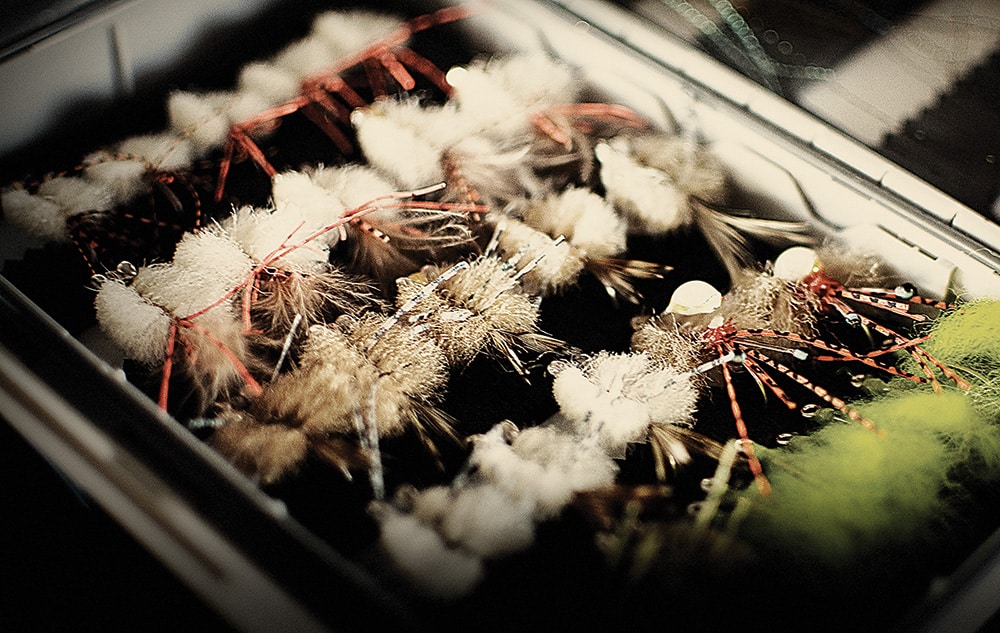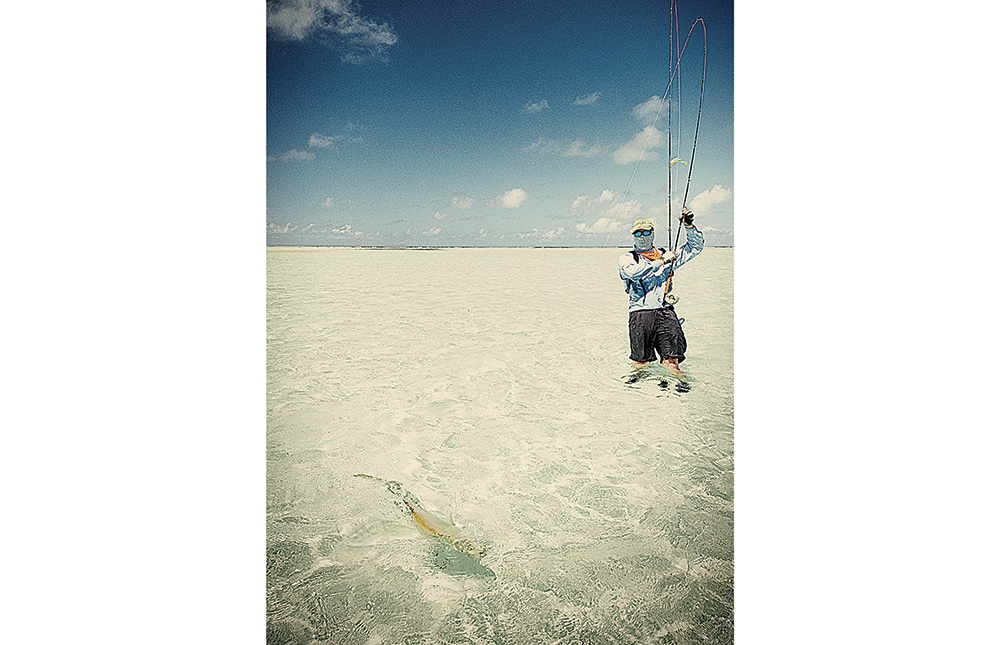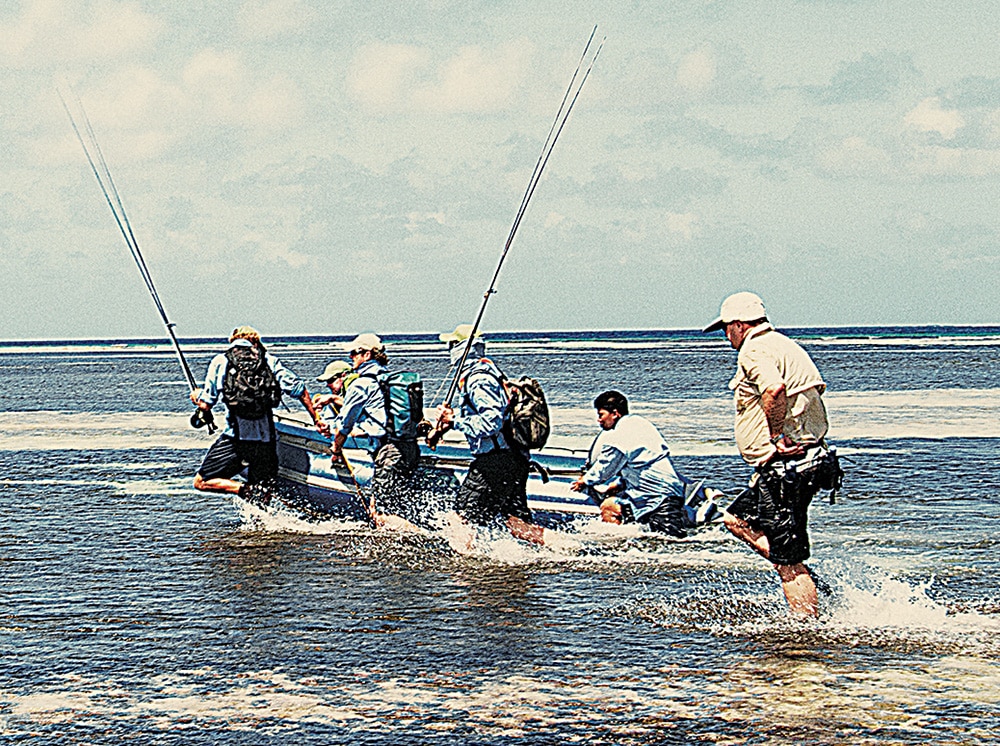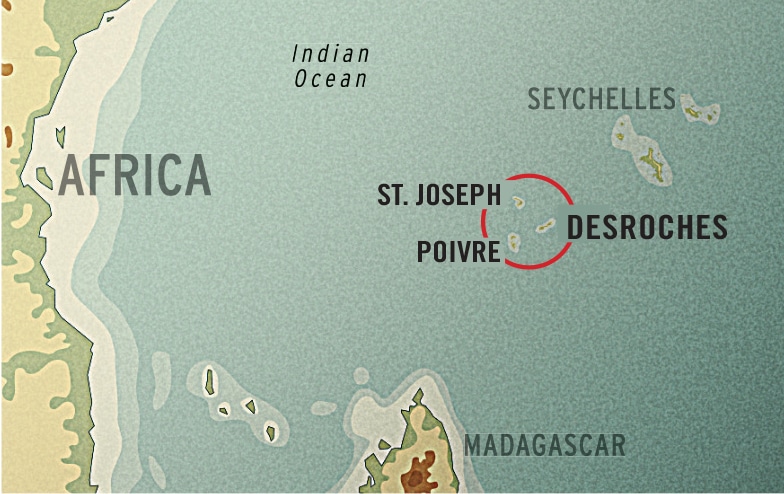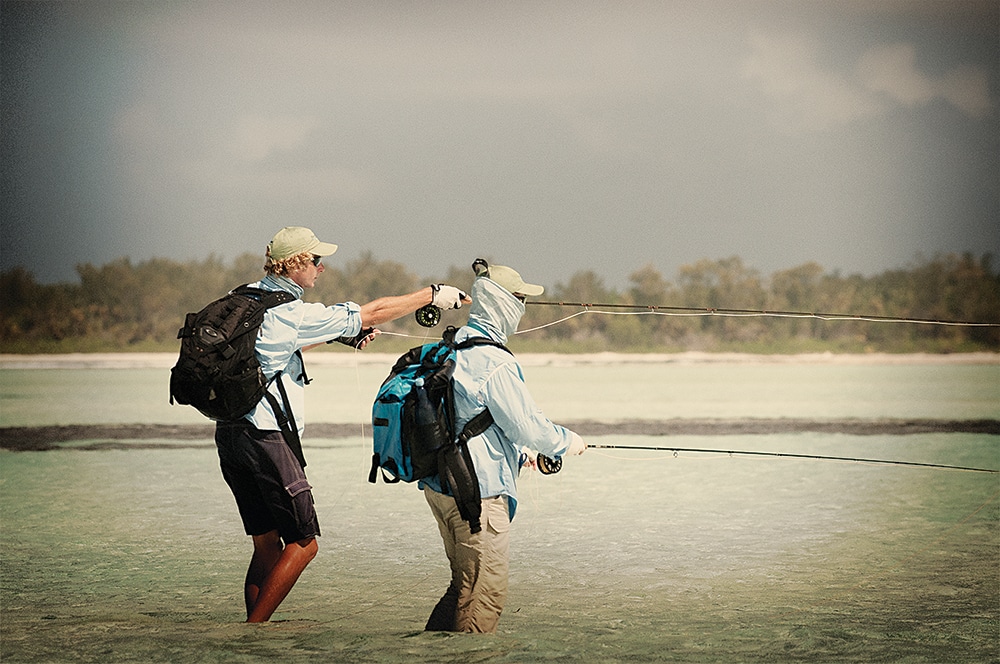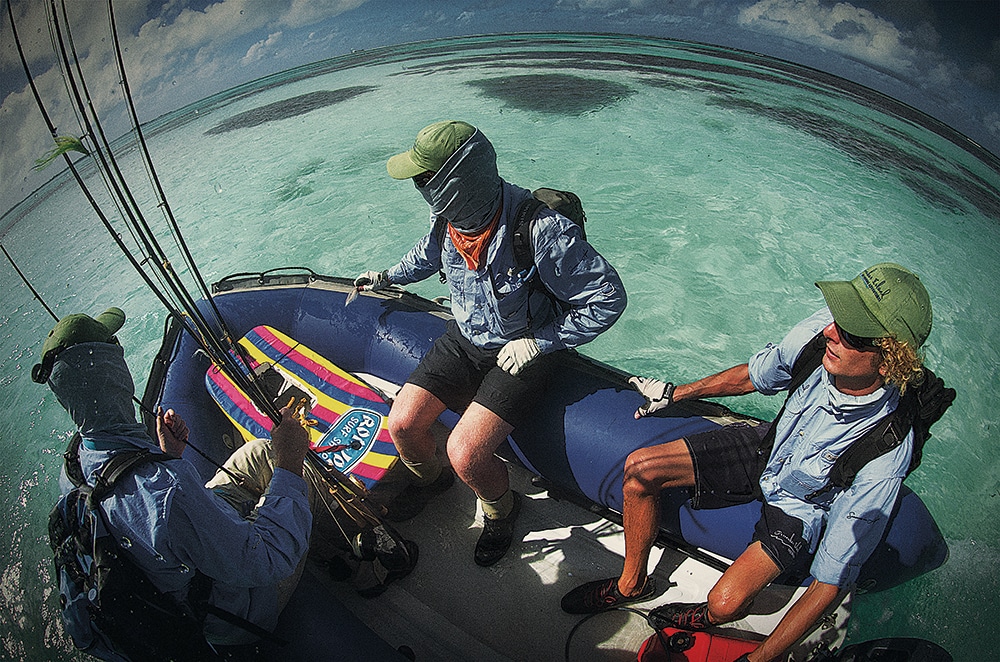
Don’t forget to click through the images in the gallery above.
**”It’s a permit,” I screamed to Kyle. **
What was it — my hundredth cast in the last two hours? Kyle Simpson and I had been knee-deep in hoards of big permit all exposing themselves in the receding tide while looking for a last supper on the southeastern side of Poivre atoll in Seychelles in the Indian Ocean. It was just the two of us, taking turns in conditions perfect for spying black tails and dorsal fins trimmed with gold.
I cleared my line and thought, “Finally.” I exhaled through my cheeks as the rod pulsed to the rhythm of the powerful tail kicks that propelled the fish toward the outer edge of the atoll, closer to the reef drop-off. I held my rod high, palmed the reel’s rim and carefully put on the brakes. The fish slowed, turning parallel to the reef crown. I’d turned it — just — and was now recovering dozens of yards of backing. With a second wind, the permit surged once more. Again I broke it from a likely fatal plunge over the reef’s edge.
High-hurdling as best he could in heavy wading boots, Kyle came over to me, camera in hand and out of breath. “Great job, Bro!” he gasped. We fist-bumped and then, incredulously, the slab of a permit was gone. A subsequent review of the seven-second video later that evening would reveal little more than a sketchy glimpse of an angler with a bent rod rebounding straight right as the camera settles on the subject. Next, a long, guttural effigy that is often used to characterize the worst of things when — “shit happens.”
Finding myself sitting at Poivre, sharing shots with a guide-in-training on a dark afternoon in October, began with a cryptic e-mail from Keith Rose-Innes in June 2012.
“Hi there, Mark!” it began. “It’s been a while since we last chatted. How’re things? Have you been fishing lately? I’ve started consulting for an operation in the Seychelles called Desroches. I want to get you out there sometime. Best, Keith.”
It had been a while since we’d last “chatted,” but his brief note seemed more like a long, tight, well-directed loop hurled at me than just a friendly “hello,” which intrigued me on several levels. First, while familiar with some fly-fishing destinations in the Seychelles, I’d never heard of Desroches. Second, his e-mail address now read “@desroches.com,” not the familiar “@flycastaway.com.” And third, “get you out there sometime” was a metaphor for “I’ve got a story right in your wheelhouse.”
Thus began a correspondence trail between Keith and me, with Fly Fishing in Salt Waters providing peripheral guidance, that culminated in my two-week visit to the Desroches Island Resort. The plan was simple: “Come to the Seychelles; train with my new guides before the start of our first client season,” Keith wrote.
It turns out, Desroches Island Resort had an established blue-water trolling operation running an Egg Harbor 35 Sport Fisherman for guests looking for the occasional day trip. However, the island’s topography does not support adequate flats fishing to justify a full-time fly-fishing operation. That said, nearby sister atolls of St. Joseph and Poivre, 24 and 26 miles distant respectively, are an entirely different matter.
Thus, Desroches Island Resort had a business case for a fly-fishing operation; it just needed an industry professional to define the capital assets required and to develop a strategy for execution. Enter Keith Rose-Innes.
I had to see what Keith had up his sleeve. It boiled down to trusting a vision he’d built on 16 years’ fly-fishing experience in the Seychelles, the last seven leading FlyCastaway as owner/operator. Having fished with FlyCastaway twice, I’d seen firsthand a fishing product that sold itself and an operation that ran so tight it squeaked. How could I go wrong?
On the first of October I arrived in Mahe with swollen ankles after 26 straight hours of travel time. To save precious checked baggage weight, I’d worn my wading boots — once my feet began to sweat after the first leg from Cincinnati to Paris, I realized this was a bad idea. My compadres in coach class would agree. But a shower stall at the Desroches Island Resort pavilion at the Mahe terminal refreshed me, clothing, stinky socks, body parts and all. In the lounge, I drip-dried, smelling of gardenias as I sipped cappuccino and awaited the final 40-minute flight to Desroches.
A contingent of staff decked out in company colors, from the hotel’s general manager to porters, moved to meet the plane as it rolled to a stop. Sweet tropical air enveloped as Keith waited in the periphery.
“There are 320 people here who keep this island running.” Keith enlightened me while we walked the length of the manicured grounds to my room, which was on the beach. Well, all hotel rooms are on the beach.
The term five-star accommodations has become overused. So how could I characterize this place without resorting to hyperbole? I’ve never had a suite at a fishing destination with two bathrooms before, nor had one including both a throne and a bidet. Which got me thinking a bit about the business model: Was it possible to run a fly-fishing operation from such a remote location that was so over-the-top?
Eventually I ran into Keith. “See you at 7:30 for dinner? Got to get back to work — close to a deal on another island we want to add to the fly-fishing operation.” Hmm, the plot thickened.
At dinner, servers exchanged silverware with every course and filled water glasses with every sip. We drank down our meals with draught SeyBrew and talked about the game plan for the days to come. Keith avoided discussing “the deal,” and I didn’t ask.
“Tomorrow we provision our 54-foot Simonis Power Yacht catamaran Aman’i for your trip to St. Joseph. You’ll meet my new guide crew tomorrow night. You’ll also meet Bryan Rapson; he’s skippering,” Keith said. “Have your gear ready by 4 p.m.; I’ll send a buggy to your room. Sorry, but I’ll not be going; we’re close to closing that deal I mentioned and I need to be here.”
Frankly, I liked the idea of hanging with the new gang independent from the boss. I’d get an honest sense of personalities and skills. Kind of like an unchaperoned boys’ week out.
I arrived at the office at 4 p.m. sharp and the crew was already assembled: South African guides-in-training Kyle Simpson, Haydyn Williams and Cameron Musgrave, skipper Bryan Rapson and first mate Rodel Reintegrado. Bryan presented a trip overview identifying mooring sites in the lee of D’Arros Island, adjacent to St. Joe, where we’d anchor up.
The crossing was slow but the big cat sliced nicely through the confused sea.
In short order we’d anchored, rigged flats tackle, donned boots and backpacks, and set out for St. Joe in the inflatable. Finally, it was time to truly explore. It was near high tide when we reached the outer edge of the flats on the lee side of St. Joe, yet we still had to drag “the ducky” nearly 100 yards over the shallows; there are no natural channels for boat transit on St. Joe’s lee side. The boys would eventually move a pair of 19-foot Mitzi skiffs from Desroches to the inner lagoon of St. Joe when weather permitted for shuttling clients to fishing sites we’d identify over the next several days.
Kyle was the only one of us that had fished St. Joe before, so I paired with him. Haydyn and Cameron dropped us at the tail of an expansive white-sand flat, then zoomed to the far side of the lagoon to learn what might be there. “This is a good flat,” Kyle remarked, stabbing his rod in several directions. “Plenty of bones over the sand and some permit farther up toward that island.”
Immediately, Kyle and I were into bones. Ironically, we struggled at first trying to dial in the wind and fly selection. Eventually limp-wrist casting gave way to tight power-stroke loops down the wind’s throat. Weighted amber flies were the ticket; the fish fest was on.
Meanwhile, on the far side of the lagoon, Cameron and Haydyn were getting on the board in similar fashion.
For the balance of the falling tide we had our chance with some groups of small permit but a shocking number of huge fish, mostly around the small island where Kyle predicted they’d be, until we left late in the afternoon.
Later, on board Aman’i we traded adventures, ate dinner, drank beer, cleaned dinner plates, stowed gear and reviewed images on the computer. Final tally: lots of bones (a few approaching six pounds) and plenty of permit shots but no “eats.”
Bryan ran a tight operation. Anchor watch, which was starting the cat’s diesel engines and running them for 10 minutes, was every two hours. We drew monofilament straws for watch times. Bryan also lectured tersely about bringing boot sand into his domain. My bad, I had worn sandy boots in his parlor. Good to be treated like one of the boys, though. Speaking of which, I started shaving daily, like my boat mates, and maintaining my jumble of stuff out of the way thanks to Bryan’s demand to run things shipshape. “How our guides behave is a reflection on not only them, but also our company,” I recall Keith saying at dinner on the first night.
But to some degree we were on holiday, so drinking beer after hours was OK and cussing added missing color to our dialog — as long as clients weren’t around.
The next morning came early and we decided to all fish together, starting at the small island where Kyle and I had found the big permit the day before. Five minutes into the session, Cameron had a shot at two big ones. Five minutes later, another permit bit but pulled the hook on the initial run. Then, not five minutes after that, he hooked yet another permit. This one would not get away; I helped Cameron land the trophy, his first.
Around noon the pushing tide ended the permit session, so we settled for some line pulls from a huge school of bonefish on an edge where the flat dropped off toward deeper water.
After a late lunch, the tide was our friend, the setting sun our enemy. For the last two hours, the fishing became red-hot. Shoals of bonefish, pods of permit and schools of milkfish fed in skinny water over mostly white-sand bottom. There were times I did not know which way to turn for my next shot.
Then it was time to go. At an hour till sunset, we had a 30-minute slog back to the inflatable and a 40-minute run to get back to Aman’i, including a coronary-inducing pull of the ducky over a nearly dry flat. Perhaps not surprisingly, the bones were easy, the permit impossible and no one had a milkfish fly.
On the third day, as we were dragging the inflatable across a flat, an unexpected call came in on the handheld radio. Keith had come over from Desroches on Flyer, a 30-foot Citation and one of two fast boats in the arsenal, with four lodge clients who wanted to bonefish. No holiday today; the boys were officially on duty. So I went along with Keith and his client, and everyone tested bonefish for the rest of the day.
“So what happened with you and FlyCastaway?” It was late into my visit and I’d finally found the stones to ask Keith the million-dollar question. We were relaxing at the bar after completing the best day of permit fishing I’d ever experienced, having lost the one while wading with Kyle. It was now or never, yet part of me was not sure I’d want the answer. I had gotten to know Keith’s former teammates at FlyCastaway and didn’t want to feel like I was picking sides by being on Desroches with another company.
Keith was retrospective. “I was burned out,” he said. “Seven years of sweat equity, continuously working the operation to secure rights to the best locations while guiding full time wore me down. As a small operation, we worked on razor margins. It was two steps forward, three back: I got tired of the bullshit — working what I thought were exclusive destination agreements only to be sold out by interests that changed the rules after all the hard work was done. Then, Somali pirates. The business model couldn’t account for that kind of crap, so I took a break.”
We ordered another drink. “At first, I told the boys I was going to take six months off. Just relax, travel, fish on my own and recover from back surgery. I was beginning to feel whole again when Kenneth Collins, a good friend and owner of Desroches, approached me about consulting. I’d fished St. Joseph and Poivre when I was a kid. My dad brought me here 20 years ago. I knew there was potential, so I said yes. For the first time in a long while, I’m excited again about the business of fly-fishing.”
Keith became more animated. “With Desroches, I now have what I could not attain at FlyCastaway: deep financial backing without personal liability. I have the resources to acquire what it takes to make this operation run. I purchased both fast boats since I arrived, Flyer and Y Knot, a 30-foot Wellcraft Scarab; both can run from here to the atolls in less time than it takes your Panhandle tarpon guides to launch and post up on their spots.” He smiled. “And, my clients have the bonus to blue-water fly-fish at both ends of the day.”
This I can testify to: Keith fished a client to his first bonefish on the opposite side of Poivre while Kyle and I were banging away at endless shoals of permit. And the same angler landed his first sailfish on fly later that afternoon, before we zoomed home for drinks.
Subconsciously recapping Keith’s unique business model, I got it. Yes, this resort, the fishing — both work. They complement in a way in which I was not familiar. To put things in a different perspective, I pondered the following: Until now, I’d never fished any place where I’d recommend my nonfishing spouse to come with me. Surely she could be less lonely sipping tropical punch on the beach or getting a massage here while I’m selfishly chasing flats fish merely an hour away. Right?
Then Keith flashed a wry smile, his teeth reflecting subdued light. “We closed the deal today,” he said. “Desroches Island Resort now manages Alphonse Island Resort, while we are in the purchasing transition that includes the fly-fishing company and exclusive fishing rights. I’ll be leaving for Alphonse next week to set up our acquired team for the season. I’ve got a vision to offer multiweek trips beginning next year: A week here at Desroches, then hop the commuter flight, and 35 minutes later you are on Alphonse for another week of completely different fishing.”
This was the big deal he had alluded to, and frankly, it was a huge deal.
“So, this clearly is grander than just Desroches,” I said. “Are there other properties you guys are looking at? Like Providence for instance? Cosmoledo?”
“Anything and everything is now possible, which is why I’m excited to be here,” he said. “The company, Desroches Island Resort, has the resources for us to expand. So while we are bringing Desroches on line and Alphonse into the family, in parallel we’ll continue to investigate other islands for exclusive operations.”
Keith and I had one more follow-up session on Poivre on a particularly windy day. While visibility was excellent, the tide was dead wrong, leaving us with high water until the last hour of the afternoon. Just when the permit started to push, it was time to go. We had numerous shots and an eat between us but no hook-ups. Leaving Poivre for the last time with its manhole-cover-size permit, I knew I’d be back.
Returning home to Desroches for the last time, it was my turn for introspection. “I suppose in a week’s time the weather will turn for good and you’ll moor the boats on the opposite side of Desroches.”
“Yes,” Keith said. “But don’t worry; come back next year during prime season to fish Alphonse. And bring your wife; she’ll love Desroches while we’re fishing another out-atoll.”
I’m pretty sure that comment was not a metaphor but a firm offer. Yeah, I’d love to see what Keith’s Indian Ocean fly-fishing business strategy would bring in the coming year. So I said, “Keith, I’m in!”

